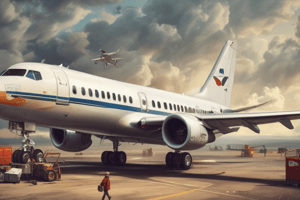Podcast
Questions and Answers
What is the primary purpose of conducting continuous training for maintenance personnel and flight crews?
What is the primary purpose of conducting continuous training for maintenance personnel and flight crews?
- To ensure compliance with FAA regulations
- To improve the overall efficiency of maintenance processes
- To reduce the risk of human error in maintenance procedures
- To maintain airworthiness and ensure the highest level of safety and reliability in aircraft operations (correct)
What is the benefit of performing self-audits and inspections?
What is the benefit of performing self-audits and inspections?
- To improve the overall quality of maintenance records
- To identify potential compliance issues before they become significant problems (correct)
- To ensure adherence to the MEL
- To reduce the frequency of FAA inspections
What is the purpose of engaging with FAA inspectors?
What is the purpose of engaging with FAA inspectors?
- To build a positive and proactive relationship with FAA inspectors (correct)
- To reduce the frequency of inspections
- To demonstrate compliance with airworthiness standards
- To request clarification on regulations
Why is documentation critical in demonstrating adherence to airworthiness standards?
Why is documentation critical in demonstrating adherence to airworthiness standards?
What is the primary benefit of leveraging technology in maintenance tracking and compliance monitoring?
What is the primary benefit of leveraging technology in maintenance tracking and compliance monitoring?
What is the purpose of planning for change management in aviation operations?
What is the purpose of planning for change management in aviation operations?
What is the ultimate goal of evaluating and improving a compliance strategy?
What is the ultimate goal of evaluating and improving a compliance strategy?
What is the importance of maintaining airworthiness in aircraft operations?
What is the importance of maintaining airworthiness in aircraft operations?
What is the benefit of having a well-informed team in aviation operations?
What is the benefit of having a well-informed team in aviation operations?
What is the ultimate goal of implementing a compliance strategy in aviation operations?
What is the ultimate goal of implementing a compliance strategy in aviation operations?
The FAA provides regular training for maintenance personnel and flight crews on current regulations and best practices.
The FAA provides regular training for maintenance personnel and flight crews on current regulations and best practices.
Self-audits can only identify compliance issues that have already become significant problems.
Self-audits can only identify compliance issues that have already become significant problems.
FAA inspectors only provide clarifications on regulations during inspections.
FAA inspectors only provide clarifications on regulations during inspections.
Documentation is only necessary for major maintenance actions.
Documentation is only necessary for major maintenance actions.
Technology is only used for maintenance tracking in aviation operations.
Technology is only used for maintenance tracking in aviation operations.
Change management protocols are only necessary for technological changes.
Change management protocols are only necessary for technological changes.
Evaluating and improving a compliance strategy is a one-time process.
Evaluating and improving a compliance strategy is a one-time process.
Airworthiness compliance is only necessary for large aircraft operators.
Airworthiness compliance is only necessary for large aircraft operators.
The primary goal of a compliance strategy is to pass inspections.
The primary goal of a compliance strategy is to pass inspections.
Only maintenance personnel are responsible for airworthiness compliance.
Only maintenance personnel are responsible for airworthiness compliance.
What is the underlying principle behind conducting continuous training for maintenance personnel and flight crews in aviation operations?
What is the underlying principle behind conducting continuous training for maintenance personnel and flight crews in aviation operations?
How can regular self-audits and inspections contribute to a robust compliance strategy in aviation operations?
How can regular self-audits and inspections contribute to a robust compliance strategy in aviation operations?
What is the key benefit of building a positive and proactive relationship with FAA inspectors in aviation operations?
What is the key benefit of building a positive and proactive relationship with FAA inspectors in aviation operations?
Why is it essential to keep detailed records of all maintenance actions, inspections, training, and compliance efforts in aviation operations?
Why is it essential to keep detailed records of all maintenance actions, inspections, training, and compliance efforts in aviation operations?
How can technology be leveraged to support maintenance tracking, compliance monitoring, and recordkeeping in aviation operations?
How can technology be leveraged to support maintenance tracking, compliance monitoring, and recordkeeping in aviation operations?
Why is it important to establish a change management protocol in aviation operations?
Why is it important to establish a change management protocol in aviation operations?
What is the primary focus of evaluating and improving a compliance strategy in aviation operations?
What is the primary focus of evaluating and improving a compliance strategy in aviation operations?
What is the ultimate goal of implementing a compliance strategy in aviation operations, beyond just passing inspections?
What is the ultimate goal of implementing a compliance strategy in aviation operations, beyond just passing inspections?
How can a well-informed team contribute to maintaining airworthiness in aviation operations?
How can a well-informed team contribute to maintaining airworthiness in aviation operations?
Why is it essential to maintain airworthiness in aviation operations, beyond just meeting regulatory requirements?
Why is it essential to maintain airworthiness in aviation operations, beyond just meeting regulatory requirements?
Flashcards are hidden until you start studying
Study Notes
Maintenance Annex Guidance (MAG)
- A bilateral agreement that simplifies the acceptance of aircraft maintenance between the FAA and other regulatory authorities
- A unifying framework that extends FAA standards across borders, allowing for a streamlined process in multinational operations
Continuous Airworthiness Maintenance Program (CAMP)
- A structured approach to ongoing maintenance, keeping the aircraft in peak condition
- A preventive healthcare plan for aircraft, continuously monitoring and acting to prevent issues
Aircraft Maintenance Records
- Outlined in 14 CFR part 43
- Standards for entries, dispositions, and retention of records
- Ensures that maintenance actions meet high standards for airworthiness
Airworthiness Directives (ADs) and Service Bulletins (SBs)
- ADs: legally enforceable rules issued by the FAA when a systemic issue affecting safety is identified
- SBs: recommendations that complement ADs and are considered best practices
- Both play a critical role in preemptive and reactive maintenance planning
Minimum Equipment List (MEL)
- An operational lifeline, detailing which equipment items may be inoperative while maintaining airworthiness
- An essential aspect of maintenance planning, ensuring safe operation even when not everything is functioning perfectly
Creating a Compliant Maintenance Plan
- A roadmap for aircraft upkeep, including necessary checks and repairs for longevity and reliability
- 8 steps to ensure compliance with FAA regulations:
- Analyze aircraft usage and requirements
- Review manufacturer's maintenance guidelines
- Incorporate Airworthiness Directives (ADs) and Service Bulletins (SBs)
- Plan for routine and unscheduled maintenance
- Create a flexible maintenance schedule
- Document maintenance activities meticulously
- Ensure compliance with 14 CFR
- Regularly review and update the maintenance plan
Ensuring Ongoing Compliance
- A continuous process requiring attention to detail and a proactive approach to aircraft maintenance and operations
- 11 steps to maintain compliance with airworthiness standards:
- Understand the regulatory framework
- Implement a systematic maintenance program
- Stay informed on Airworthiness Directives (ADs)
- Regularly review and update equipment lists
- Conduct continuous training
- Perform self-audits and inspections
- Engage with FAA inspectors
- Document everything
- Leverage technology
- Plan for change management
- Evaluate and improve
Module Overview
- This module covers the significance of FAA documentation in maintenance planning, ensuring airworthiness of aircraft.
Maintenance Planning
- Meticulous maintenance planning is crucial to ensure aircraft are fit to fly and operate safely.
- It involves planning, recording, and complying with maintenance schedules.
Core FAA Documentation
- Airplane Flight Manual (AFM): standard for maintenance, detailing specifications, limitations, and procedures.
- Aircraft Logbook: records every repair, inspection, and maintenance activity, akin to a diary, to track the aircraft's history and health.
International Standards
- Maintenance Annex Guidance (MAG): a bilateral agreement simplifying acceptance of aircraft maintenance between FAA and other regulatory authorities.
Continuous Airworthiness Maintenance Program (CAMP)
- A structured approach to ongoing maintenance, aiding in keeping aircraft in peak condition.
Regulatory Specifics
- 14 CFR Part 43: outlines requirements for Aircraft Maintenance Records, including standards for entries, dispositions, and retention of records.
Airworthiness Directives (ADs) and Service Bulletins (SBs)
- ADs: legally enforceable rules issued by the FAA for systemic safety issues.
- SBs: recommendations, often complementing ADs, regarded as best practices.
Minimum Equipment List (MEL)
- Updates are necessary for defective equipment, ensuring airworthiness during specific conditions.
Creating a Compliant Maintenance Plan
- Steps to ensure a plan aligns with FAA standards:
- Analyze aircraft usage and requirements.
- Review manufacturer's maintenance guidelines.
- Incorporate Airworthiness Directives (ADs) and Service Bulletins (SBs).
- Plan for routine and unscheduled maintenance.
- Create a flexible maintenance schedule.
- Document maintenance activities meticulously.
- Ensure compliance with 14 CFR.
- Regularly review and update the maintenance plan.
Additional Compliance Strategies
- Conduct continuous training for maintenance personnel and flight crews.
- Perform self-audits and inspections to identify potential compliance issues.
- Engage with FAA inspectors and build a positive relationship.
- Document everything, including maintenance actions, inspections, training, and compliance efforts.
- Leverage technology for maintenance tracking, compliance monitoring, and recordkeeping.
- Plan for change management to adapt to industry changes.
- Evaluate and improve the compliance strategy regularly.
Maintenance Planning and FAA Documentation
- Maintenance planning is crucial in aviation as it ensures airworthiness and safety
- FAA documentation plays a pivotal role in maintenance planning, and understanding it is essential for compliance and safety
- The Airplane Flight Manual (AFM) is the standard for maintenance and outlines specifications, limitations, and procedures for keeping the aircraft in prime condition
Aircraft Logbook and Maintenance Records
- The aircraft logbook is a vital record of all repairs, inspections, and maintenance activities
- It chronicles the life of the aircraft and is essential for determining its history and health
International Standards and FAA Guidance
- The Maintenance Annex Guidance (MAG) is a bilateral agreement that simplifies the acceptance of aircraft maintenance between the FAA and other regulatory authorities
- The Continuous Airworthiness Maintenance Program (CAMP) is a strategic tool that supports ongoing maintenance and aids in keeping the aircraft in peak condition
Regulatory Specifics and Airworthiness Directives
- 14 CFR part 43 outlines the requirements for aircraft maintenance records and standards for entries, dispositions, and retention of records
- Airworthiness Directives (ADs) are legally enforceable rules issued by the FAA to correct unsafe conditions
- Service Bulletins (SBs) are recommendations that complement ADs and are regarded as best practices
Minimum Equipment List (MEL) and Defective Equipment
- The MEL is an operational lifeline that delineates which equipment items may be inoperative while maintaining airworthiness during specific conditions
- Updating the MEL is essential for ensuring that the aircraft can operate safely even when not everything is functioning perfectly
Creating a Compliant Maintenance Plan
- A compliant maintenance plan is crucial for ensuring safety and airworthiness
- The plan should analyze aircraft usage and requirements, and enlist all necessary checks and repairs to promote longevity and reliability of flight operations
- Familiarizing oneself with relevant Federal Aviation Regulations (FARs) and implementing a systematic maintenance program are essential steps in creating a compliant plan
Ensuring Ongoing Compliance with Airworthiness Standards
- Understanding the regulatory framework, implementing a systematic maintenance program, and staying informed on Airworthiness Directives (ADs) are crucial steps in ensuring ongoing compliance
- Regularly reviewing and updating equipment lists, conducting continuous training, and performing self-audits and inspections are also essential
- Documenting everything, leveraging technology, planning for change management, and evaluating and improving the compliance strategy are critical in maintaining airworthiness standards
Studying That Suits You
Use AI to generate personalized quizzes and flashcards to suit your learning preferences.




